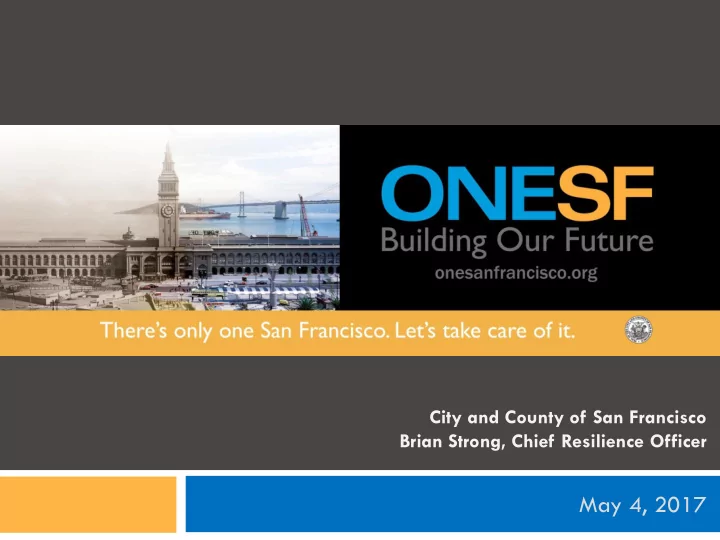

City and County of San Francisco Brian Strong, Chief Resilience Officer May 4, 2017
Resilience Planning in San Francisco 2 Disaster mitigation and recovery policies Expanded definition of resilience on the 100 RC model: Consider disaster preparedness and recovery for both infrastructure and communities
Critical Challenges to Resilience Planning 3 Creating a sense of urgency Long-term planning and implementation in a political environment Traditional building code focus on life-safety rather than recovery Issues of equity, displacement, housing, demographics, and population growth Encouraging the private sector to address resiliency Lack of funding for mitigation and planning efforts Changes at the federal level
Neighborhood Population Risk Factors 4 Neighborhoods with risk factors require additional resources for disaster response Place-based analysis enables impactful outreach and capacity building
Access To Services 5 Analysis compares several population measures to the City as a whole Allows targeted investments in communities of need
Capital Planning for Public Infrastructure Resilience 6 Establishes a long-term plan of finance Creates the basis for investment decisions and project implementation Demonstrates sound financial management Means for communicating with a wide range of audiences
10-Year Capital Plan 7 Constrained 10-year plan of finance Created in 2006 to coordinate and prioritize infrastructure investments Objective and transparent review and recommendation process Current plan proposes to spend $35 billion through 2027 Accomplishments Over $10 billion approved since 2006 $3.5 billion GO bonds since 2008 Ongoing Policies & Programs Pay-As-You-Go GO Bonds GF Debt Revenue Bonds
DEBT PROGRAM General Obligation (G.O.) Bond Schedule 8 G.O. Bond Debt Program (in $millions) Proposed Program Amount Election November 2018 Seawall Fortification $350 November 2019 Parks and Open Space $185 November 2020 Earthquake Safety & Emergency Response $290 November 2022 Public Health $300 November 2024 Transportation $500 June 2025 Parks and Open Space $185 November 2026 Earthquake Safety & Emergency Response $290 TOTAL $2,100...
DEBT PROGRAM General Obligation (G.O.) Bond Capacity 9
Major Project Seawall Fortification Project 10 San Francisco’s Great Seawall was built in 1878 and runs three miles along waterfront. It supports business and infrastructure on the waterfront and protects the City against flooding. The Seawall is vulnerable to earthquakes and must be strengthened. The estimated cost to fully replace is $2-5 billion.
Major Project: Emergency Firefighting Water System 11 Build ability to meet full water demand after an earthquake Citywide reliability after projects Citywide reliability 2010 96% 47%
HAZUS – Where Are The Risks? 12 Liquefaction Ground Shaking San Andreas M7.9 Hayward M6.9
Questions & Comments 13 www.onesanfrancisco.org
Local Hire Projects Cumulative Work Hours March 25, 2011 – March 1, 2017 14 14
Seismic Hazard Rating Categories 15 SHR Description SHR-1 Minor damage (good performance). Some structural or nonstructural damage and/or falling hazards may occur, but these would pose minimal life hazards to occupants. The damage can be repaired while the building is occupied and with minimum disruptions to functions. SHR-2 Moderate damage (fair performance). Structural and nonstructural damage and/or falling hazards are anticipated which would pose low life hazards to occupants. The damage can be repaired while the building is occupied. SHR-3 Major damage (poor performance). Structural and nonstructural damage are anticipated which would pose appreciable life hazards to occupants. The building has to be vacated during repairs, or possibly cannot be repaired due to the extent and/or economic considerations. SHR-4 Partial/total collapse (very poor performance). Extensive structural and nonstructural damage, potential structural collapse and/or falling hazards are anticipated which would pose high life hazards to occupants. There is a good likelihood that damage repairs would not be feasible.
ECP Leadership Academy PROGRAM OUTCOMES SKILLS Empower diverse, emerging community leaders with tools and skills to create high- performing volunteer teams that identify and achieve collective goals. TRUST Increase the level of trust and reciprocity between neighborhood leaders and the agencies and institutions committed to their success to ensure mutual accountability. KNOWLEDGE Grow participant awareness of SF programs, processes and services that can help catalyze positive change. NETWORK Grow participant awareness of SF programs, processes and services that can help catalyze positive change.
Community Resilience 17 Community Resilience Indicators – 2012 The Community Resiliency Indicator System uses 38 indicators to approximate vulnerability and resiliency in San Francisco. These indicators fall into the following domains: Hazard Indicators, Environmental Indicators, Transportation Indicators, Community Indicators, Public Realm Indicators, Housing Indicators, Economy Indicators, Health Indicators, and Demographic Indicators.
Neighborhood Empowerment Network 18 Why it’s important Neighborhoods are diverse and needs are not identical Government must be nimble in its approach to tailor services for unique populations Developing leaders at the neighborhood level allows the City to expand its reach post-disaster Community-based partners possess unique resources that the City cannot provide
Recommend
More recommend